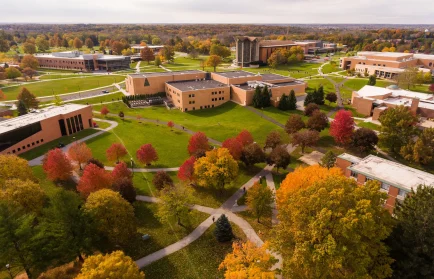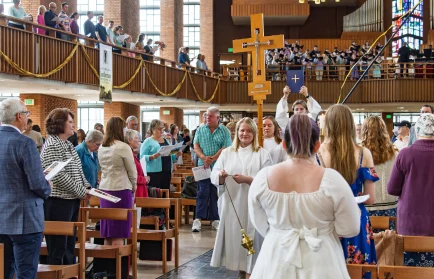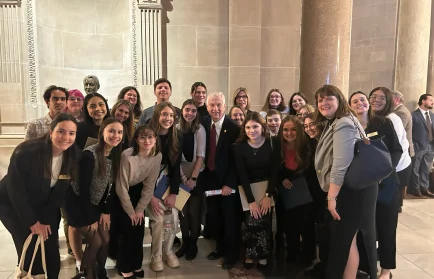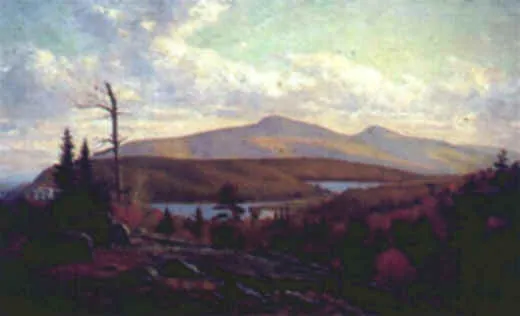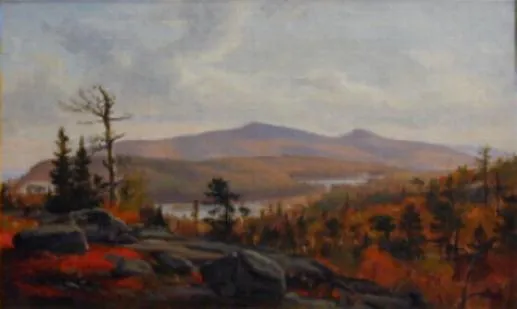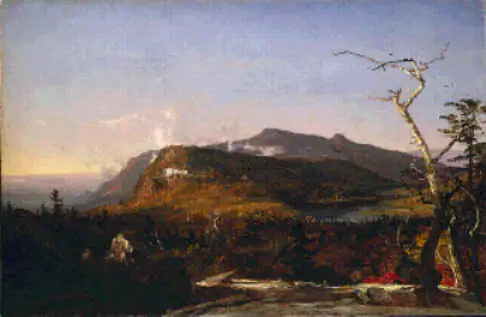The Story of an American Cultural Icon
A Virtual Exhibition sponsored by the Valparaiso University Brauer Museum of Art
Story of An American Cultural Icon
You are looking at an area that covers about a four mile radius, at the eastern edge about twelve miles west of the Hudson River. This setting has inspired many artists, including Junius Sloan. Here’s a description of each site along your journey.
If you want to see the Catskill Mountain House from below in a painting by Thomas Cole’s sister Sara, head for the last big bend in the stage road.
Approach to the Mountain House
A view of the Mountain House that many painters admired was from a big bend in the old stage road that came up the escarpment near North Mountain. First built in the Federalist style, the Mountain House later adopted a more Neo-Classical look, with thirteen huge Corinthian columns in front giving it the look of a Greek temple.
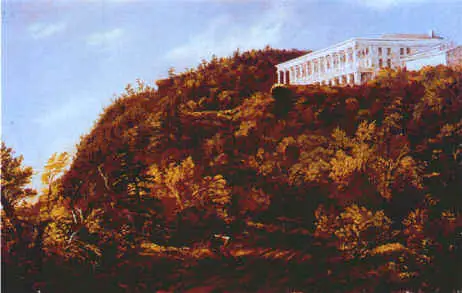
Sara Cole (1805-1857), A View of the Catskill Mountain House, oil on canvas, 1841, 15 x 23 1/4 inches, Albany Institute of History and Art.
Interested in description of the view from the first luxury resort hotel in America? Your tour guide here will be James Fenimore Cooper.
View From the Mountain House
Natty Bumppo, hero of James Fenimore Cooper’s Leatherstocking Tales, describing the view from the site where the Catskill Mountain House would be built:
“There’s a place in them hills that I used to climb to, when I wanted to see the carryings on of the world, that would well pay any man for a barked shin or a torn moccasin. You know the Catskills, lad, for you must have seen them on your left, as you followed the river up from York, looking as blue as a piece of clear sky, and holding up the clouds on their tops, as the smoke curls over the head of an Indian chief at the council fire. Well, there’s the High-peak and Round-top, which lay back, like a father and mother among their children, seeing they are high above all the other hills. But the place I mean is next to the river, where one of the ridges juts out a little from the rest, and where the rocks fall for the best part of a thousand feet, so much up and down, that a man standing on their edges is fool enough to think he can jump from top to bottom.”
“What see you when you get there?” asked Edwards.
“Creation!” said Natty, dropping the end of his rod into the water, and sweeping one hand around him in a circle — “all creation, lad…”
James Fenimore Cooper, from The Pioneers
How about visiting Kaaterskill Falls, waterfalls higher than Niagara Falls? You could go there for your honeymoon– many did. View an image by Cole.
View of Kaaterskill Falls
“And now I must turn to another of the beautifiers of the earth– the Waterfall; which in the same object at once presents to the mind the beautiful, but apparently incongruous idea, of fixedness and motion– single existence in which we perceive unceasing change and everlasting duration.”
Thomas Cole, from “An Essay on American Scenery
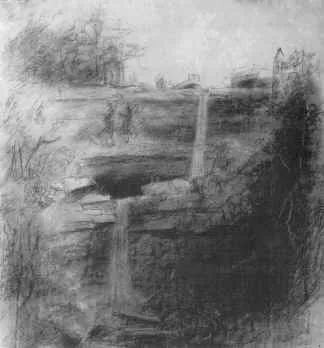
Thomas Cole, Double Waterfall — Kaaterskill Falls, ca. 1825, pencil, charcoal, black-and-white crayon on paper, 16 1/2 x 14 5/8 inches, Detroit Institute of Arts, Founders Society Purchase, William H. Murphy Fund (39.503). Photograph © 1994, the Detroit Institute of Art.
Provides dramatic overviews by Junius Sloan of the Kaaterskill Clove, a deep valley that became the unofficial outdoor painting school for American landscape painters during the 19th century.
Overview of the Kaaterskill (Facing West)
One of the oldest hiking trails in America is one that looks out over the Kaaterskill Clove. In this image, Junius Sloan, on that trail, is looking west towards Haines Falls, with Hunter Mountain in the background.
“There is one season when the American forest surpasses all the world in gorgeousness — that is the autumnal; then every hill is radiant in the luxury of color; every hue is there from the liveliest green to the deepest purple, from the most golden yellow to the intensest crimson. The artist looks despairingly on the glowing landscape, and in the old world his truest imitations of the American forest, at this season, are called falsely bright, and scenes in Fairy Land.”
Thomas Cole, from “On American Scenery”
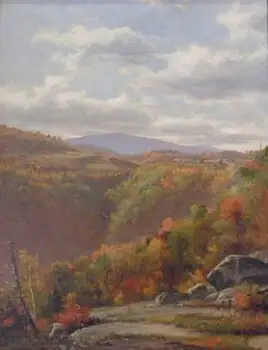
Junius R. Sloan (1827-1900), Kaaterskill Clove with View of Haines Falls and Hunter Mountain, oil on canvas on board, 18 1/8 x 14 3/16 inches, Brauer Museum of Art, Percy H. Sloan Trust, 1953.1.179.
The view from this site gives you a fine Junius Sloan painting of the Clove.
Overview of the Kaaterskill (Facing West)
“The most distinctive, and perhaps, the most impressive, characteristics of American scenery, is its wilderness.”
Thomas Cole, from an “Essay on American Scenery”
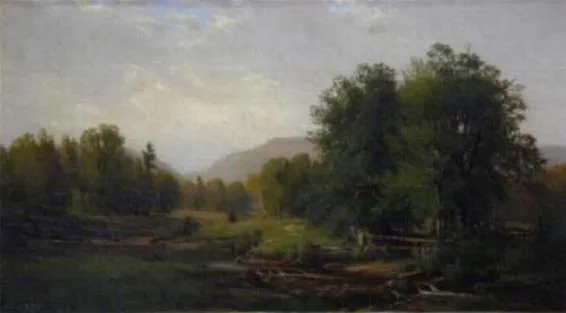
Junius R. Sloan (1827-1900), Gray Day in the Catskills, 1881, oil on canvas, 20 1/8 x 36 3/16 inches, Brauer Museum of Art, Percy H. Sloan Trust, 53.01.068.
“It is a spot to make a man solemnize. You can see right down into the valley that lies to the east of the High-Peak, where, in the fall of the year, thousands of acres of woods are for your eyes, in the deep hollow, and along the side of the mountain, painted like ten thousand rainbows, by no hand of man, though not without the ordering of God’s providence.”
Natty Bumppo, looking into the Clove from the top of Kaaterskill Falls, from James Fenimore Cooper’s The Pioneers
Takes you into the Clove to see famous images by Asher B. Durand and one of Junius Sloan’s finest landscapes.
In Kaaterskill Cove
“The waterfall may be called the voice of the landscape, for, unlike the rocks and woods which utter sounds as the passive instruments played on by the elements, the waterfall strikes its own chords, and rocks and mountains re-echo in rich unison. And this is a land abounding in cataracts…”
Thomas Cole, from “An Essay on American Scenery”
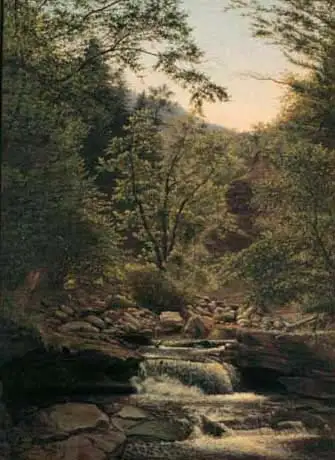
Junius R. Sloan (1827-1900), Small Falls, Kaaterskill Clove, 1860, oil on canvas on masonite, 19 1/2 x 14 1/2 inches, Brauer Museum of Art, Percy H. Sloan Trust, 1953.1.148.
Here Durand paints the portraits of important kindred spirits Thomas Cole and poet Willian Cullen Bryant, whose poetry ushered in the American Romantic movement.
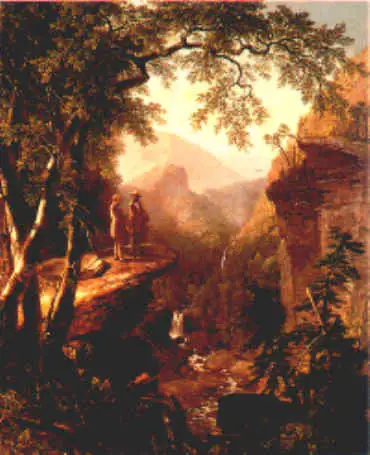
Asher B. Durand, Kindred Spirits, 1848, oil on canvas, 46 x 36 inches, Collections of The New York Public Library, Astor, Lenox and Tilden Foundations.
In the classic Washington Irving tale, Rip Van Winkle becomes one of the earliest sight seers in the Catskills. In the first paragraph he gives us the view from the Pine Orchard, to become four years later the site of the Catskill Mountain House. In the second paragraph, he gives Americans their first view into Kaaterskill Clove. Irving has judiciously sent Rip up the mountain during the fall, the very best time for the American landscape to distinguish itself, according to Thomas Cole.
In a long ramble… on a fine autumnal day, Rip has unconsciously scrambled to one of the highest parts of the Kaatskill mountains. …Panting and fatigued, he threw himself, late in the afternoon, on a green knoll, covered with mountain herbage, that crowned the brow of a precipice. From an opening between the trees, he could overlook all the lower country for many a mile of rich woodland. He saw at a distance the lordly Hudson far below him, moving on its silent but majestic course, the reflection of a purple cloud, or the sail of a lagging bark, here and there sleeping on its glassy bosom, and at last losing itself in the blue highlands.
On the other side he looked down into a deep mountain glen, wild, lonely, and shagged, the bottom filled with fragments from the impending cliffs, and scarcely lighted by the reflected rays of the setting sun.”
Washington Irving, from The Sketchbook of Geoffrey Crayon, Gent.
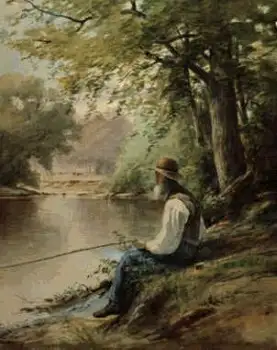
Junius Sloan (1827-1900), Landscape Fisherman, Hindsdale, Illinois, watercolor on paper, 14 1/2 x 11 5/8 inches. Brauer Museum of Art, Percy H. Sloan Trust. 53.101.337.
Map of the Larger Area
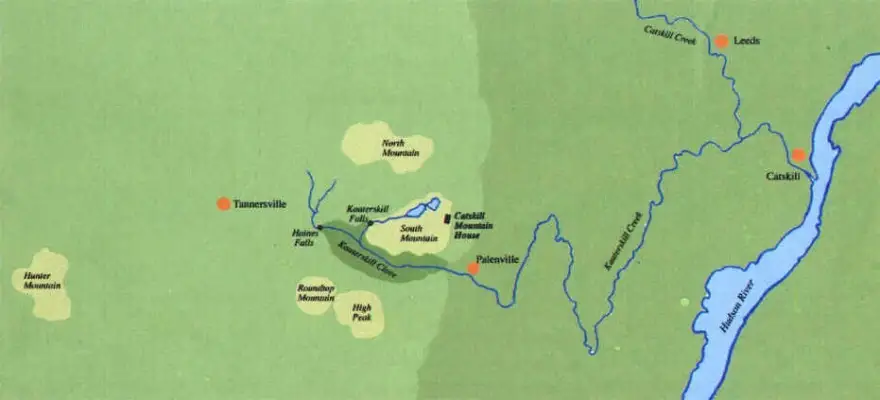
Bibliography
Cole, Thomas. “Essays on American Scenery.” The Collected Essays and Prose Sketches. The John Colet Archive of American Literature, Volume 7. Marshall Tymn, ed. St. Paul: John Colet Press, 1980.
Cooper, James Fenimore. The Pioneers. James Wallace, ed. New York: Oxford University Press,1991.
Irving, Washington. “Rip Van Winkle.” The Norton Anthology of American Fiction, 5th ed. Nina Baym, ed. New York: W.W Norton and Co., 1998.
Van Zandt, Roland. The Catskill Mountain House. Hensonville: Black Dome Press Corp, 1997.
Get In Touch.
The Brauer Museum is closed for the summer. We look forward to seeing you when we re-open for the fall semester!
Brauer Museum of Art
Valparaiso University
Center for the Arts
1709 Chapel Drive
Valparaiso, IN 46383-6493
